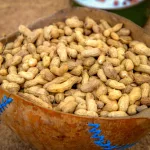What is Nigerian Sorghum?
Nigerian sorghum is a type of cereal grain that’s grown and widely consumed in Nigeria, a country located in West Africa. It’s a significant crop in Nigerian agriculture and plays a vital role in the country’s food security. Sorghum is not exclusive to Nigeria and is also cultivated in many other parts of Africa, as well as around the world.
Nigerian sorghum comes in different varieties, and it’s a versatile and resilient crop that can thrive in various environmental conditions. This adaptability makes it a popular choice among Nigerian farmers.
Read, Also >>>>>> Comparative Analysis, Nutritional And Health Benefits, Physical & Chemical Properties Of Nigerian Palm Oil
In Nigeria, sorghum is used in a variety of traditional and modern dishes. It’s a key ingredient in Nigerian cuisine, where it’s used to make porridge, soups, and various types of bread. Sorghum is prized for its nutritional value, being a good source of energy, fiber, and essential minerals.
In addition to being a staple food, sorghum is also used to produce traditional Nigerian alcoholic beverages, such as “ogi” and “burukutu.” These beverages are an integral part of Nigerian culture and are made through the fermentation of sorghum grains.
So, in a nutshell, Nigerian sorghum is a vital grain in Nigerian agriculture and culinary culture. It’s a versatile crop that’s used in a wide range of dishes and has both economic and cultural significance in the country.
Comparative Analysis of Nigerian Sorghum
1. Varieties:
Nigerian sorghum encompasses a diverse range of varieties. Some of the notable ones include white sorghum, red sorghum, and Guinea sorghum. These varieties differ in color, size, and adaptability to specific regions within Nigeria.
2. Nutritional Value:
Sorghum is highly nutritious. It’s rich in carbohydrates, fiber, and essential minerals, particularly iron and phosphorus. The nutritional value of Nigerian sorghum makes it an important dietary component, especially for those who rely on it as a staple food.
3. Culinary Use:
Nigerian sorghum is a versatile ingredient in the country’s cuisine. It’s used to prepare various dishes, such as “tuwo,” a thick porridge-like food, and “sorghum fufu.” Additionally, sorghum is employed in the production of local alcoholic beverages like “ogi” and “burukutu.” These beverages hold cultural significance in Nigeria.
4. Economic Impact:
Sorghum is a vital cash crop for many Nigerian farmers. It provides a source of income for agricultural communities, contributing to the country’s economy. Moreover, it’s often used as livestock feed, which supports the livestock industry.
5. Environmental Resilience:
Sorghum is known for its adaptability to different ecological zones in Nigeria. It can withstand drought and poor soil conditions better than some other crops. This resilience makes it a dependable crop in regions with unpredictable weather patterns.
6. Research and Development:
In recent years, there has been an increasing focus on improving the yield and quality of Nigerian sorghum through research and development efforts. This has led to the introduction of high-yielding sorghum varieties that are disease-resistant and more resilient.
7. Export Potential:
Nigerian sorghum has export potential, as it is in demand not only in domestic markets but also in neighboring African countries. The export of sorghum contributes to Nigeria’s foreign exchange earnings.
Nigerian sorghum is a valuable and versatile crop with significant economic, nutritional, and cultural importance. Its adaptability, resilience, and export potential make it a key player in the agricultural landscape of Nigeria, and ongoing research and development efforts aim to enhance its productivity and economic impact further.
Read, Also >>>>>> Comparative Analysis, Nutritional And Health Benefits, Physical & Chemical Properties Of Nigerian Palm Oil
Nutritional Properties of Nigerian sorghum
1. Carbohydrates:
Nigerian sorghum is primarily composed of carbohydrates, making it an excellent source of energy. It provides complex carbohydrates, which are slow to digest, leading to sustained energy levels and helping to control blood sugar.
2. Dietary Fiber:
Sorghum is rich in dietary fiber, which aids digestion and promotes a feeling of fullness. This fiber content can help prevent overeating and assist in weight management. It also supports a healthy gut by nourishing beneficial gut bacteria.
3. Protein:
Sorghum contains a decent amount of protein, which is crucial for muscle development and repair. It is a valuable protein source for vegetarians and can be combined with other protein-rich foods to form a balanced diet.
4. Essential Minerals:
Sorghum is notably high in essential minerals such as phosphorus and magnesium. Phosphorus is vital for bone health, while magnesium plays a role in various biochemical processes in the body, including muscle and nerve function.
5. Iron:
Iron is essential for the production of red blood cells and for preventing anemia. Nigerian sorghum, particularly the darker varieties, is a good source of iron.
6. B Vitamins:
Sorghum contains various B vitamins, including niacin (B3), thiamine (B1), and riboflavin (B2). These vitamins are essential for converting food into energy and supporting overall health.
7. Antioxidants:
Sorghum contains antioxidants, such as phenolic compounds, which help protect the body against oxidative stress and reduce the risk of chronic diseases.
8. Gluten-Free:
One significant advantage of sorghum is that it is naturally gluten-free. This makes it a safe and nutritious choice for individuals with celiac disease or gluten sensitivity.
9. Low Fat Content:
Sorghum is relatively low in fat, making it a healthy option for those looking to reduce their fat intake.
10. Low Glycemic Index:
The complex carbohydrates in sorghum have a low glycemic index, meaning they are slowly digested and absorbed, leading to gradual increases in blood sugar levels. This is beneficial for individuals with diabetes or those aiming to control blood sugar levels.
Nigerian sorghum is a nutritionally rich grain with a range of health benefits. Its high fiber content, essential minerals, and antioxidants make it a valuable addition to a balanced diet. It offers a sustainable source of energy, supports digestive health, and can contribute to overall well-being.
Health Benefits of Nigerian Sorghum
1. Heart Health:
Sorghum is heart-healthy due to its high fiber content, which can help lower cholesterol levels. A diet rich in fiber is associated with a reduced risk of heart disease, as it can help regulate blood pressure and improve overall cardiovascular health.
2. Weight Management:
The dietary fiber in sorghum promotes a feeling of fullness, reducing the likelihood of overeating. This can aid in weight management and help prevent obesity, a risk factor for numerous health issues.
3. Diabetes Management:
Sorghum has a low glycemic index, which means it doesn’t cause rapid spikes in blood sugar levels. This makes it a suitable choice for individuals with diabetes, helping them maintain better blood sugar control.
4. Digestive Health:
The fiber in sorghum supports digestive health by preventing constipation and promoting regular bowel movements. It also nourishes beneficial gut bacteria, contributing to a healthy gut microbiome.
5. Bone Health:
Sorghum is a good source of phosphorus and magnesium, both of which are vital for maintaining strong and healthy bones. Adequate phosphorus intake is essential for bone formation and repair.
6. Energy Boost:
Sorghum’s complex carbohydrates provide a sustained source of energy, making it an excellent choice for individuals looking to maintain energy levels throughout the day.
7. Antioxidant Protection:
Sorghum contains antioxidants, including phenolic compounds, which help protect the body against oxidative stress. This can reduce the risk of chronic diseases, including certain types of cancer.
8. Gluten-Free Option:
Sorghum is naturally gluten-free, making it a safe and nutritious grain for individuals with celiac disease or gluten sensitivity. It allows them to enjoy grains without the risk of adverse reactions.
9. Anemia Prevention:
The iron content in sorghum, especially in the darker varieties, can help prevent iron deficiency anemia by supporting the production of red blood cells.
10. Versatile Ingredient:
Sorghum’s versatility in Nigerian cuisine allows for a wide range of delicious and nutritious dishes, ensuring that people can incorporate it into their diet in various forms.
Nigerian sorghum offers a multitude of health benefits, from supporting heart and digestive health to aiding in weight management and diabetes control. Its nutritional richness and versatility make it a valuable addition to a healthy and balanced diet.
Read, Also >>>>>> Comparative Analysis, Nutritional And Health Benefits, Physical & Chemical Properties Of Nigerian Palm Oil
Physical Properties of Nigerian Sorghum
1. Size and Shape:
Nigerian sorghum grains typically vary in size and shape. They are small and round, resembling small beads. However, there can be some variations in size and shape among different sorghum varieties.
2. Color:
Sorghum grains come in various colors. Nigerian sorghum includes white sorghum, red sorghum, and Guinea sorghum, each with its distinct color. White sorghum is pale or cream-colored, while red sorghum has a reddish or brown hue.
3. Texture:
The texture of sorghum grains is relatively hard and smooth. When you run your fingers over the grains, you’ll notice a polished, glossy surface. This hardness is due to the protective outer layer of the grain.
4. Awns:
Some varieties of sorghum have awns, which are hair-like extensions at the top of the grains. These awns can vary in length and are more common in wild or traditional varieties.
5. Kernel Attachment:
Sorghum kernels are typically attached to a central stalk, forming a characteristic cluster. This arrangement is often referred to as a “panicle.”
6. Weight:
The weight of sorghum grains can vary depending on factors like moisture content and variety. They are generally light when compared to other cereal grains like maize (corn) and wheat.
7. Uniformity:
Sorghum grains are relatively uniform in size and shape within the same variety, making them easy to handle and process.
8. Storage Characteristics:
Sorghum has good storage characteristics due to its hard texture, which helps protect it from pests and moisture. Properly stored sorghum can have a long shelf life.
9. Husk or Pericarp:
Each sorghum grain is encased in a husk or pericarp, which acts as a protective layer. The color and thickness of this husk can vary among sorghum varieties.
10. Germination:
Sorghum seeds have the potential to germinate and grow into new plants if provided with the right conditions. This germination property is essential for sorghum as a crop.
In summary, Nigerian sorghum exhibits various physical properties, including size, color, texture, and the presence of awns. These characteristics can vary among different sorghum varieties and have important implications for their use in agriculture and food processing.
Chemical Properties of Nigerian Sorghum
1. Macronutrient Composition:
- Carbohydrates: Sorghum is primarily composed of carbohydrates, including starch. The carbohydrate content can vary among different sorghum varieties and is an important energy source in the diet.
- Protein: Sorghum contains protein, although the protein content can be lower compared to some other grains. The protein content varies by variety and can be enhanced through breeding and cultivation practices.
- Fats: Sorghum typically has a low fat content. The fat present in sorghum is mainly in the form of unsaturated fats.
Nutritional Properties of Nigerian Sorghum
|
Quantity |
100g |
|
Calories |
390.64 kcl |
|
Fat |
6.3g |
|
Protein |
9.7g |
|
Carbohydrate |
68.5g |
2. Fiber Content:
- Dietary Fiber: Sorghum is a good source of dietary fiber, which includes both soluble and insoluble fibers. Dietary fiber is important for digestive health and may help in managing cholesterol levels.
3. Micronutrient Composition:
- Minerals: Sorghum contains essential minerals, including iron, phosphorus, magnesium, and potassium. Iron is crucial for red blood cell production, while phosphorus and magnesium are important for bone health and overall body function.
- Vitamins: Sorghum also contains various B vitamins, such as thiamine (B1), riboflavin (B2), and niacin (B3). These vitamins are essential for converting food into energy and supporting overall health.
Macronutrient Properties of Nigerian Sorghum
|
Weight |
100g |
|
Energy |
1679.57Kj |
|
Calories |
390.64kcl |
|
Fat |
6.3g |
|
Protein |
9.7g |
|
Carbohydrate |
68.5g |
|
Fiber |
3.50g |
|
Water |
8.72g |
4. Antioxidants:
- Phenolic Compounds: Sorghum contains phenolic compounds, which act as antioxidants. These compounds help protect cells from oxidative damage and may reduce the risk of chronic diseases.
5. Phytochemicals:
- Tannins: Some sorghum varieties may contain tannins, which are natural compounds that can affect nutrient absorption and have potential health benefits.
6. Gluten-Free:
- Sorghum is naturally gluten-free, making it a safe grain for individuals with celiac disease or gluten sensitivity.
7. Starch Content:
- Sorghum grains contain starch, which is a complex carbohydrate. The starch content can vary among sorghum varieties and impacts its cooking and processing properties.
8. Sugar Content:
- Sorghum can contain natural sugars, which contribute to its flavor. The sugar content may vary among different varieties, affecting the taste of foods and beverages made from sorghum.
Nigerian sorghum has a diverse chemical composition, with variations in macronutrients, micronutrients, antioxidants, and phytochemicals depending on the specific variety. Its chemical properties contribute to its nutritional value and suitability for various culinary uses, as well as its potential health benefits.
Read, Also >>>>>> Comparative Analysis, Nutritional And Health Benefits, Physical & Chemical Properties Of Nigerian Palm Oil
Ways to Use Nigerian Sorghum
Nigerian sorghum is a versatile grain that can be used in various ways in the kitchen. Here are some popular ways to use Nigerian sorghum:
- Porridge (Tuwo): One of the most traditional uses of sorghum in Nigerian cuisine is to make a thick porridge known as “tuwo.” Sorghum flour is mixed with water and cooked to a thick, dough-like consistency. It’s often served with soups or stews.
- Sorghum Fufu: Sorghum can be used to make fufu, a starchy side dish commonly served with soups or sauces. Sorghum fufu is prepared by cooking sorghum flour with water to form a dough-like consistency, which is then shaped into balls or served in mounds.
- Pap (Ogi): Sorghum can be used to make a popular Nigerian breakfast dish called “ogi” or “pap.” It’s a smooth, cereal-based porridge often served with milk, sugar, or other toppings.
- Sorghum Bread: Sorghum flour can be used to make a variety of bread, including flatbreads and more traditional Nigerian bread recipes. It can be combined with other grains for added flavor and texture.
- Sorghum Pancakes: You can use sorghum flour to make fluffy pancakes, similar to traditional wheat-based pancakes. These pancakes are enjoyed with toppings like syrup, honey, or fruits.
- Sorghum Snacks: Sorghum grains can be popped and seasoned to make a healthy, crunchy snack similar to popcorn. They can be flavored with spices, herbs, or sweeteners for a tasty treat.
- Sorghum Soups and Stews: Whole sorghum grains or sorghum flour can be added to soups and stews as a thickening agent or to provide a hearty texture. This is common in Nigerian dishes like okra soup and egusi soup.
- Sorghum Beverages: Sorghum is used to make traditional Nigerian alcoholic beverages like “burukutu.” The grains are fermented to create a tangy, mildly alcoholic drink.
- Sorghum Cereals: You can use sorghum to make hot cereals by cooking sorghum grains with water or milk. Add sweeteners, fruits, or nuts for extra flavor.
- Sorghum Salads: Cooked sorghum grains can be added to salads for a unique and nutritious twist. They provide a hearty, chewy texture to salads and work well with various vegetables and dressings.
- Sorghum Puddings and Desserts: Sorghum can be used in dessert recipes, such as sorghum pudding or sweet sorghum snacks. It adds a slightly nutty and sweet flavor to these treats.
- Sorghum Flour in Baking: Sorghum flour can be used as a gluten-free alternative in baking recipes. It’s suitable for making cakes, muffins, cookies, and other baked goods.
Incorporating Nigerian sorghum into your meals not only adds a unique flavor but also offers the nutritional benefits of this versatile grain. Whether in traditional Nigerian dishes or modern recipes, sorghum can be a healthy and delicious choice.
Recipes Using Nigerian Sorghum
Here are two recipes using Nigerian sorghum:
1. Sorghum Porridge (Tuwo)
Ingredients:
- 1 cup of Nigerian sorghum flour
- 3 cups of water
- Salt to taste
Instructions:
- In a saucepan, bring 3 cups of water to a boil.
- While the water is boiling, mix the sorghum flour with a small amount of cold water to make a smooth, thick paste.
- Slowly pour the sorghum paste into the boiling water, stirring continuously to avoid lumps.
- Reduce the heat to low and let the mixture simmer, stirring occasionally to prevent sticking. It will start to thicken and become dough-like.
- Continue to cook for about 10-15 minutes until the porridge is fully cooked and has a firm, dough-like consistency.
- Season with salt to taste.
- Serve hot with your choice of Nigerian soup or stew, such as egusi soup or okra soup.
2. Sorghum Pancakes
Ingredients:
- 1 cup Nigerian sorghum flour
- 1/2 cup all-purpose flour
- 2 tablespoons sugar
- 1 1/2 teaspoons baking powder
- 1/2 teaspoon salt
- 1 cup milk
- 1 large egg
- 2 tablespoons melted butter or oil
- 1 teaspoon vanilla extract (optional)
- Cooking oil for frying
Instructions:
- In a mixing bowl, combine the sorghum flour, all-purpose flour, sugar, baking powder, and salt.
- In another bowl, whisk together the milk, egg, melted butter or oil, and vanilla extract (if using).
- Pour the wet ingredients into the dry ingredients and stir until just combined. Be careful not to overmix; a few lumps are okay.
- Heat a non-stick skillet or griddle over medium heat and lightly grease it with cooking oil.
- Pour 1/4 cup portions of the pancake batter onto the hot skillet. Cook until bubbles form on the surface, then flip and cook the other side until golden brown.
- Continue with the remaining batter, adding more oil to the skillet as needed.
- Serve the sorghum pancakes hot with your choice of toppings, such as maple syrup, honey, fresh fruits, or yogurt.
These recipes showcase the versatility of Nigerian sorghum, whether in traditional dishes like tuwo or in a modern recipe like sorghum pancakes. Enjoy these nutritious and delicious meals!
Potential Side Effects and Things to Remember
While Nigerian sorghum is a nutritious and versatile grain, it’s important to be aware of potential side effects and considerations when incorporating it into your diet. Here are some things to remember:
1. Allergies:
- Some individuals may have allergies or sensitivities to sorghum. If you experience allergic reactions such as hives, swelling, or difficulty breathing after consuming sorghum, seek medical attention.
2. Digestive Issues:
- Sorghum is high in dietary fiber, which can cause digestive discomfort, especially if you’re not used to a high-fiber diet. Gradually increase your sorghum intake to allow your digestive system to adjust.
3. Phytates and Antinutrients:
- Sorghum contains phytates and other antinutrients that can inhibit the absorption of certain minerals like iron and zinc. If sorghum is a significant part of your diet, consider diversifying your sources of these minerals or using preparation methods like soaking and cooking to reduce phytate levels.
4. Gluten Sensitivity:
- While sorghum is naturally gluten-free, cross-contamination during processing and storage can occur. If you have celiac disease or non-celiac gluten sensitivity, ensure that the sorghum you use is certified gluten-free.
5. Moderation:
- As with any food, it’s essential to consume sorghum in moderation as part of a balanced diet. Excessive consumption can lead to overconsumption of calories and carbohydrates.
6. Preparation Methods:
- The way you prepare sorghum can affect its nutritional content. Boiling or steaming sorghum is a healthier option than frying or heavily processing it.
7. Food Safety:
- When using sorghum in recipes, follow proper food safety guidelines for storing, handling, and cooking to prevent foodborne illnesses.
8. Individual Tolerance:
- Everyone’s tolerance to sorghum may vary. Pay attention to how your body reacts to sorghum consumption. If you experience adverse effects, consider limiting or adjusting your intake.
9. Medication Interactions:
- Sorghum’s compounds can interact with certain medications. If you are on specific medications, consult with a healthcare professional to ensure there are no adverse interactions.
Remember that sorghum is generally safe and nutritious, and any potential side effects or issues are often related to individual sensitivities or overconsumption. By being mindful of your diet and listening to your body’s response, you can enjoy the health benefits of Nigerian sorghum while minimizing any potential side effects.
Nigerian sorghum is a versatile and nutritious grain that holds significant cultural and culinary importance in Nigeria. It offers a range of health benefits, including supporting heart health, aiding in weight management, and contributing to diabetes control. Its adaptability and resilience make it a valuable crop in Nigerian agriculture, and it plays a key role in traditional dishes and modern recipes.
When using Nigerian sorghum, remember to be mindful of potential side effects, especially if you have allergies or digestive sensitivities. Enjoy it in moderation as part of a balanced diet to reap its nutritional benefits.
Whether you’re savoring a bowl of sorghum porridge, preparing sorghum pancakes, or incorporating it into your favorite dishes, Nigerian sorghum can be a delicious and nutritious addition to your culinary repertoire. So, explore the diverse ways to use this grain, savor its unique flavors, and savor the cultural richness it brings to your table.
Read, Also >>>>>> Comparative Analysis, Nutritional And Health Benefits, Physical & Chemical Properties Of Nigerian Palm Oil











